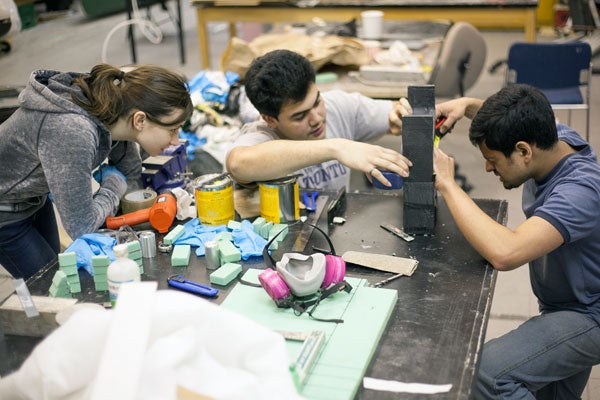
This car travels 1,152 kilometres on one litre of fuel
Published: May 26, 2014
How much do you think it costs to drive from Toronto to Vancouver in the U of T Supermileage Team’s new eco-car? Hint: it’s less than a medium latte from your favourite coffee shop.
Unveiled at the international Shell Eco-marathon this month, the tiny car from U of T engineering students is capable of traveling 1,152 kilometres on a single litre of fuel. For a cross-country trip, that’s $4.70.
In this year’s competition, Supermileage won two design awards and placed second overall, thanks to an engine they redesigned from scratch. Taking place in Houston, TX, the packed weekend saw students compete from across Canada, the United States, Mexico, Brazil, Chile and Guatemala.
U of T Engineering’s Sydney Goodfellow spoke with Supermileage co-captain Jonathan Hamway about his experiences in this year’s competition, and why he thinks next year’s team is poised to break the record for the world’s most fuel-efficient car.
Your team measured nearly double the mileage of your car last year. Are these the results you expected?
Initially, we predicted the engine would reach around 1,700 kilometres per litre, but we didn’t have time to tune it, and our clutch was causing a lot of friction, so we actually ran a lot faster than we should have considering those set-backs.
All we really wanted was to finish a race so that we could qualify for the awards. When we saw we were in first place for most of the weekend, it was just icing on the cake. We knew there was so much more that we could have achieved.
In addition to placing in second, you also won a Technical Innovation Award and the Pennzoil Tribology Award. Can you share what these awards mean?
The Technical Innovation Award is based specifically on engine design. The award [recognized] how we were able to incorporate different technologies that haven’t been put together in a small engine before.
The Pennzoil Tribology Award was about using tribology principles, like wear and friction, and how we were able to optimize those in our engine for ultimate efficiency. [The judges] based the award on the principles we used for material selection, like lubricants, and how we put everything together to improve overall efficiency.
What was the atmosphere like at this year’s competition?
We changed the competition completely. We were the only team with a completely custom-built engine. When the judges saw our engine, their jaws were locked open. Our design was like nothing they’d ever seen before. We definitely inspired people, and that was the best part of the competition to me.
Next year, we’re going to see a lot of teams trying what we tried. We didn’t hide anything; we told them how we designed it, built it and anything they wanted to know. It’s up to them to actually do it, knowing how much work it is.
Fuel efficiency is a relevant topic around the world today. What impact do you think your innovations could have?
This competition is essentially about pushing the absolute limits of what you can do when you only look at fuel efficiency…the principles we used are very applicable. Small engines in scooters, for example, have a lot of room for improvement and could use some of our principles.
You already see some of our designs in cars, too, like whole or partial engine deactivation in hybrids, causing the engine to switch off when you get up to speed. Our engine was actually off for most of the race.
In terms of the actual geometries we chose – the coatings, how we mixed the fuel and created turbulence in the chamber – those are proprietary to us and haven’t been explored too much [by other small engine manufacturers], but I think they definitely should be.
This is why soon we will be displaying the engine at several other design showcases that are more investor-based. That’s where we’ll be talking about transforming and applying our design for other engine-powered vehicles and machines.
You’ve claimed that next year’s team will break the record for the world’s most fuel-efficient vehicle – how?
For next year’s competition, we are planning to spend more time tuning the engine and making the car’s body lighter and more aerodynamic.
It’s not about breaking the record – that is the easy part.
Our biggest challenge will be transferring knowledge, as a lot of our team members are graduating and leaving the team. Next year is about bringing in new talent and teaching them everything.



